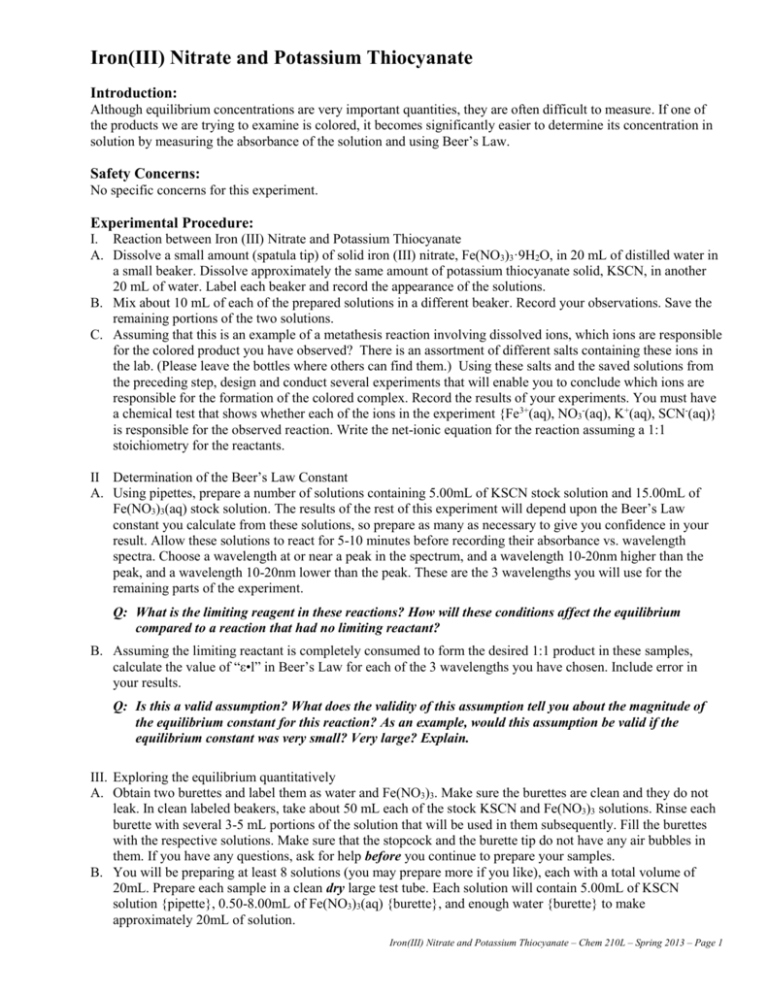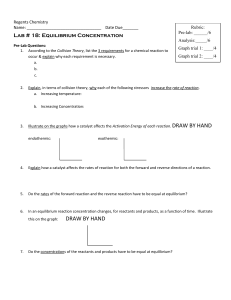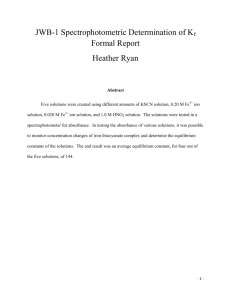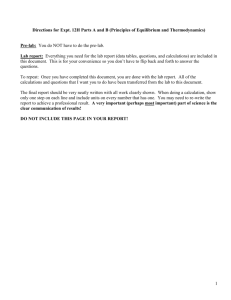Iron(III) Nitrate & Potassium Thiocyanate Lab Experiment
advertisement

Iron(III) Nitrate and Potassium Thiocyanate
Introduction:
Although equilibrium concentrations are very important quantities, they are often difficult to measure. If one of
the products we are trying to examine is colored, it becomes significantly easier to determine its concentration in
solution by measuring the absorbance of the solution and using Beer’s Law.
Safety Concerns:
No specific concerns for this experiment.
Experimental Procedure:
I. Reaction between Iron (III) Nitrate and Potassium Thiocyanate
A. Dissolve a small amount (spatula tip) of solid iron (III) nitrate, Fe(NO3)3·9H2O, in 20 mL of distilled water in
a small beaker. Dissolve approximately the same amount of potassium thiocyanate solid, KSCN, in another
20 mL of water. Label each beaker and record the appearance of the solutions.
B. Mix about 10 mL of each of the prepared solutions in a different beaker. Record your observations. Save the
remaining portions of the two solutions.
C. Assuming that this is an example of a metathesis reaction involving dissolved ions, which ions are responsible
for the colored product you have observed? There is an assortment of different salts containing these ions in
the lab. (Please leave the bottles where others can find them.) Using these salts and the saved solutions from
the preceding step, design and conduct several experiments that will enable you to conclude which ions are
responsible for the formation of the colored complex. Record the results of your experiments. You must have
a chemical test that shows whether each of the ions in the experiment {Fe3+(aq), NO3-(aq), K+(aq), SCN-(aq)}
is responsible for the observed reaction. Write the net-ionic equation for the reaction assuming a 1:1
stoichiometry for the reactants.
II Determination of the Beer’s Law Constant
A. Using pipettes, prepare a number of solutions containing 5.00mL of KSCN stock solution and 15.00mL of
Fe(NO3)3(aq) stock solution. The results of the rest of this experiment will depend upon the Beer’s Law
constant you calculate from these solutions, so prepare as many as necessary to give you confidence in your
result. Allow these solutions to react for 5-10 minutes before recording their absorbance vs. wavelength
spectra. Choose a wavelength at or near a peak in the spectrum, and a wavelength 10-20nm higher than the
peak, and a wavelength 10-20nm lower than the peak. These are the 3 wavelengths you will use for the
remaining parts of the experiment.
Q: What is the limiting reagent in these reactions? How will these conditions affect the equilibrium
compared to a reaction that had no limiting reactant?
B. Assuming the limiting reactant is completely consumed to form the desired 1:1 product in these samples,
calculate the value of “ε•l” in Beer’s Law for each of the 3 wavelengths you have chosen. Include error in
your results.
Q: Is this a valid assumption? What does the validity of this assumption tell you about the magnitude of
the equilibrium constant for this reaction? As an example, would this assumption be valid if the
equilibrium constant was very small? Very large? Explain.
III. Exploring the equilibrium quantitatively
A. Obtain two burettes and label them as water and Fe(NO3)3. Make sure the burettes are clean and they do not
leak. In clean labeled beakers, take about 50 mL each of the stock KSCN and Fe(NO3)3 solutions. Rinse each
burette with several 3-5 mL portions of the solution that will be used in them subsequently. Fill the burettes
with the respective solutions. Make sure that the stopcock and the burette tip do not have any air bubbles in
them. If you have any questions, ask for help before you continue to prepare your samples.
B. You will be preparing at least 8 solutions (you may prepare more if you like), each with a total volume of
20mL. Prepare each sample in a clean dry large test tube. Each solution will contain 5.00mL of KSCN
solution {pipette}, 0.50-8.00mL of Fe(NO3)3(aq) {burette}, and enough water {burette} to make
approximately 20mL of solution.
Iron(III) Nitrate and Potassium Thiocyanate – Chem 210L – Spring 2013 – Page 1
C. Mix your samples thoroughly and allow them to react for 5-10 minutes before recording their spectra. It is
easiest to mix these solutions by covering the tube (rubber stopper or Parafilm) and inverting the tube several
times. You will need to note the absorbance of each sample at the 3 wavelengths you chose in Part II.A.
Q: What is the limiting reagent in each of these samples? If you make the same assumption as in Part IIB
above, what would you expect the absorbance of each solution to be? Is this what you observe? What
does this observation tell you about the magnitude of the equilibrium constant for this reaction? It
may be helpful to look at these data graphically, prepare a plot of absorbance vs. initial iron(III)
concentration. Explain any trend you see in your data.
D. Calculate the initial concentrations {after mixing but before reacting} of the ions responsible for the observed
reaction for each of the samples you have prepared. Using the value of “ε•l” calculated above, calculate the
equilibrium concentration of colored product in each of your samples. Once you know the initial
concentration of each reactant and the equilibrium concentration of product, you should be able to calculate
the equilibrium concentrations of all species and calculate the equilibrium constant for the reaction.
Q: Is the value of the equilibrium constant consistent with your predictions earlier in the experiment?
Explain any deviations.
Iron(III) Nitrate and Potassium Thiocyanate – Chem 210L – Spring 2013 – Page 2











